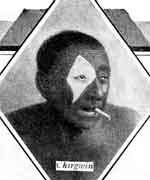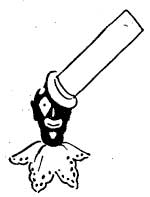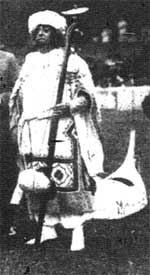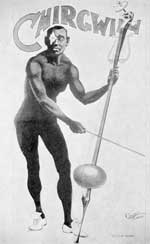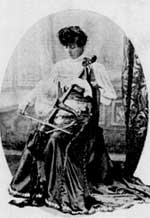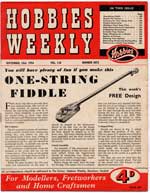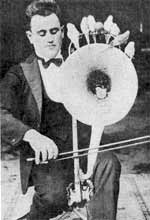 | |||||||

|
the phonofiddle the one-string japanese fiddle the life of g.h. chirgwin |
|
|
G.H. Chirgwin the White Eyed Musical Kaffir, (1854-1922), had a career in British music-hall lasting over fifty years. A multi-instrumentalist comic of considerable ability and charisma, he was the last great virtuoso of the bladder-and-string, and particularly noted for his playing on the one-stringed Japanese fiddle, an English bowed mono-chord. Chirgwin also played piano, violin, cello, mandoline, guitar, banjo, phono-fiddle, harp, dulcimer, euphonium, concertina, xylophone, sleigh bells, harmonica, bassoon, bagpipes and kettledrums. Chirgwin was a 'burnt-cork' artist; his own particular take on the black-face 'nigger-minstrels' of the streets of his childhood took the form of a blackened face with a white diamond patch over one eye. And always a bizarre combination of black and white costume finished off with an exaggeratedly tall bell-topper hat. George Chirgwin was genuinely interested and experimental in his approach to musical instruments, and claimed, with more exaggeration than accuracy, to have introduced the Japanese fiddle to the London public. Several years before Chirgwin graduated from the provincial halls, a Mr. Raynor played the Japanese fiddle in 1871 in a manner that was something more amusing than enchanting. By 1888, Chirgwin's name was a household word'; he played'The Minstrel Boy' on the Japanese fiddle in a manner that should obtain him the appointment of chief fiddler to the Mikado. One-String Japanese Fiddles Structurally the one-string fiddle is long-necked, bowed monochord and with a resonating box of a variety of shapes and materials. The kokyu, Japan's only bowed string instrument, may have been the model for the British-made Japanese fiddle. It was probably heard on the London music-hall stage for the first time in 1867, accompanying the performance of a Japanese Juggling troupe. The dismal accompaniment, played on the musical instruments of Japan...endur[ed] nearly the whole evening (The Times Feb 14, 1867). Reviews of British performers playing the Japanese fiddle began to appear in the press within a year or so of the arrival of the Japanese troupe. On the other hand, the one-string Japanese fiddle is much closer structurally to the mid-nineteenth century Chinese banhu, which has a flat wooden sound board instead of the snake-skin membrane of the kokyu, and a hollowed gourd or coconut shell sound-box. Chirgwin claimed to have made his first Japanese fiddle out of a cigar box, and to have improved it by substituting a half cocoanut shell. A novelty instrument of the music-hall, one-string fiddles were also popular with itinerant street musicians and amateur players. They were relatively cheap, they were easy to play by ear, and they were surprisingly loud. They could be home-made - the cigar-box fiddle - or could be put together from a pre-fabricated kit. A number of one-string fiddle tutors were published from 1910 until at least 1932; all were aimed at the relatively untrained player and offered a crash course in musical theory. In 1933, one-string violins were still being advertised in Australia at 7/- each. The Bombass Another of Chirgwin's favourite instruments was the Bombass. He claimed to have invented it - a claim more ficticious than factual - and made it out of a long bit of wood, a bit of old rope, a pig's bladder and a shark's jawbone for a bow. Dressed in a bizarre Indian outfit, he played it - at the Music-Hall sports in 1909. Mr. Chirgwin was armed with a curious musical instrument described as a 'bombass', from which he contrived to extract much quaint melody. The Phonofiddle In February1906 Chirgwin's one-string fiddle acquired a horn. At the Palace Theatre (London) he introduced with great success his new Japanese fiddle with a funnel attachment which not only deepens and mellows the tone but makes the instrument more powerful. The addition of a horn was the invention of the London musical instrument maker, Arthur Thomas Howson (1866-1928) Howson registered the 'Phonofiddle' trademark a few months after Chirgwin's first performance on the new instrument. Howson's early training was as an accordion maker in his father's Nottingham workshop. He became perhaps the only musical instrument maker to concentrate solely on one-stringed horned fiddles. Obviously inspired by Augustus Stroh's horned violin, the phonofiddle used a gramophone-type sound-box, inset into the body, rather than the external aluminium diaphragm of the Stroh violin. Howson developed quite a range of phonofiddles; the size and quality of the sound boxes varied, horns were of different diameters and of different materials - copper, aluminium or brass. The 'Grand Concert' model played by Chirgwin had a compass of over three octaves. By 1910, five different models were advertised, and by the mid-twenties, two-string phonofiddles, phono-ukuleles, and phono-mandolines were on offer. The idea of one-string fiddles with mechanical amplification was taken up by a number of other makers; the most popular alternative was Geo. Evans & Co., 'Stroh' Jap Fiddle, and Barnett Samuel & Sons, Ltd., 'Euphonella Viol'. Frank Hussey, meteorologist on Shakleton's expedition, took one with him to the Antarctic In 1921. Howson Phonofiddle advertising warned the buyer to beware of worthless imitations. The Howson-Chirgwin collaboration was evidently a close one, as Chirgwin's photograph and his endorsement - the last phonofiddle you made me is the finest one-string fiddle I have ever played on - appeared in advertising for Howson's instruments. Similar Chirgwin endorsement also appeared in the Phonofiddle Tutor, written and published in 1910 by L. E. [Laura Ellen] Howson, violin teacher and wife of A.T. Howson. Towards the end of his career, Chirgwin, with the phonofiddle with one string...played 'She wore a wreath of roses' with a great deal of feeling at the Royal Command Performance in 1912. A year earlier, at a benefit held in Chirgwin's honour to mark the Golden Jubilee of his stage career, A 'phono-fiddle' specially made for Mr. Chirgwin was presented by Mr. Howson. Chirgwin Recordings Reviews of Chirgwin's performances indicate a consistent association of a particular song with a particular instrument. 'My Fiddle is My Sweetheart' - violin, 'Blind Boy' - cello, 'She Wore a Wreath of Roses' - one-string fiddle or phonofiddle. This last one was recorded in 1906. (Edison Bell cylinder) Chirgwin is announced as playing the one-string Japanese fiddle, but a comparison with Rupert Hazell's 1928 phonofiddle recording suggests that he actually played a horned phonofiddle. The edgy brassiness of the sound is suggestive of mechanical amplification, at any rate. Chirgwin may possibly have played a Stroh violin in his recordings of 'My Fiddle is My Sweetheart' and 'Blind Boy' (sung in an extraordinary falsetto). If so, this is the one instrument that Chirgwin did not boast about playing. Perhaps, like so many 'legitimate' violinists of the early, pre-electric recording days, Chirgwin was reluctant to admit to using a mechanically amplified instrument for recording. Other Phonofiddlers Among the comic instrumentalists of the music-hall who played the phono-fiddle were Lona, a little girl who in 1909, played the violin, phono-fiddle, and xylophone most artistically, and Fred Wildon, The Original Phonofiddle soloist and Musical Gollywog, who also made phono-fiddle recordings. The Stroh Jap one-string fiddles seem to have been less popular with the stage professionals, but were used by Gwen Rogers Musical Dolls, a female quartet who also recorded in 1926. These popular stars must have provided inspiration for amateur musicians and itinerant street players, who could chose from a range of cheap instruments, with accompanying tutors for self-tuition. The duo comedy team, Bennett and Williams appeared in Pathe Pictures Ltd. pictorial reviews playing phonofiddle duets in the 1930s, as did Rupert Hazell. 'Grand Concert' Howson Phonofiddles were the instruments of choice for all three. Post Script: Chirgwin in Australia In 1896/1897 Chirgwin toured Australia for six months on the Tivoli vaudeville circuit. The temperature on the day he landed was 141 degrees in the sun, 93 degrees in the shade. Chirgwin was not an immediate hit with the perspiring great unwashed of the gallery. Perhaps his jokes about the weather fell a little flat. Eccentric off the stage as well as on, the Melbourne press noted his generosity in handing out gold coins stamped with his own image to those who appealed to him. It was also observed that he was quite the family man, regularly seen walking his children around St. Kilda. Always with an eye to an advertising opportunity, Chirgwin exhibit[ed] portraits of himself, nursing his latest baby, in Melbourne shop-windows. One reporter suggested: A free tip: Let him be photoed black, wearing his professional rig, nursing blacked baby with the familiar white eye, and rejoice in a valuable advert. Chirgwin performed in Broken Hill and in Bendigo, where he received a glowing review: Then advanced upon the stage a slim figure dressed in a flowing gown of shot silk, and capped with an enormous silk belltopper, adjusted in dexterous fashion upon his head. The 'white eye' was concealed beneath the hat, but the audience was not slow in recognising 'the Kaffir.' ...from a table on which lay many musical instruments, Mr. Chirgwin took an instrument resembling a guitar, with one string. From this single cord he drew a flood of melody which captivated his audience...after a short interval, when he returned relieved of his great coat and belltopper, and stood before them a study in 'black and white' - with his white eye and black face and his closely fitting suit, black in front and white behind...but in his 'Song to my Fiddle' the White-eyed Kaffir outdid his previous performances. The selection set out in a most original manner why the singer's fiddle should be termed his sweetheart, and contained passages pathetic and bright in strange confusion. The final item was 'The Song of the Blind Boy,' which Mr. Chirgwin sang in a falsetto voice to his own accompaniment on the violincello. The item was excellently given, and with a pathos which had the effect of toning the feelings of all into restraint, after the merry moments previously spent. The Bendigo Advertiser, May 17, 1897. Chirgwin was paid a fabulous sum for his Australian tour; 100 pounds a week, from which, according to the press, he sent 1,500 pounds to his London banking account...which represented his surplus Australian income up to date... He goes 'Ome with a glowing description of Australia and a good word for the people who appreciated his musical ability. © Alison Rabinovici For enquiries on the subject of G.H. Chirgwin, the cellocordo, Howson's phonofiddles, one-string Japanese fiddles, please contact Alison Rabinovici For more on Chirgwin's time in Australia, see: Chirgwin, G. H. Chirgwin's Chirrup: Life and Reminiscences of George Chirgwin, the 'White-Eyed Musical Kaffir.' London: J & J Bennett, 1912. Some viewers of this page may be offended by the common racist terminology and casual insults used at the time in which Chirgwin lived. To remove those quotations however would give a false sanitised image of that era. |
 |
